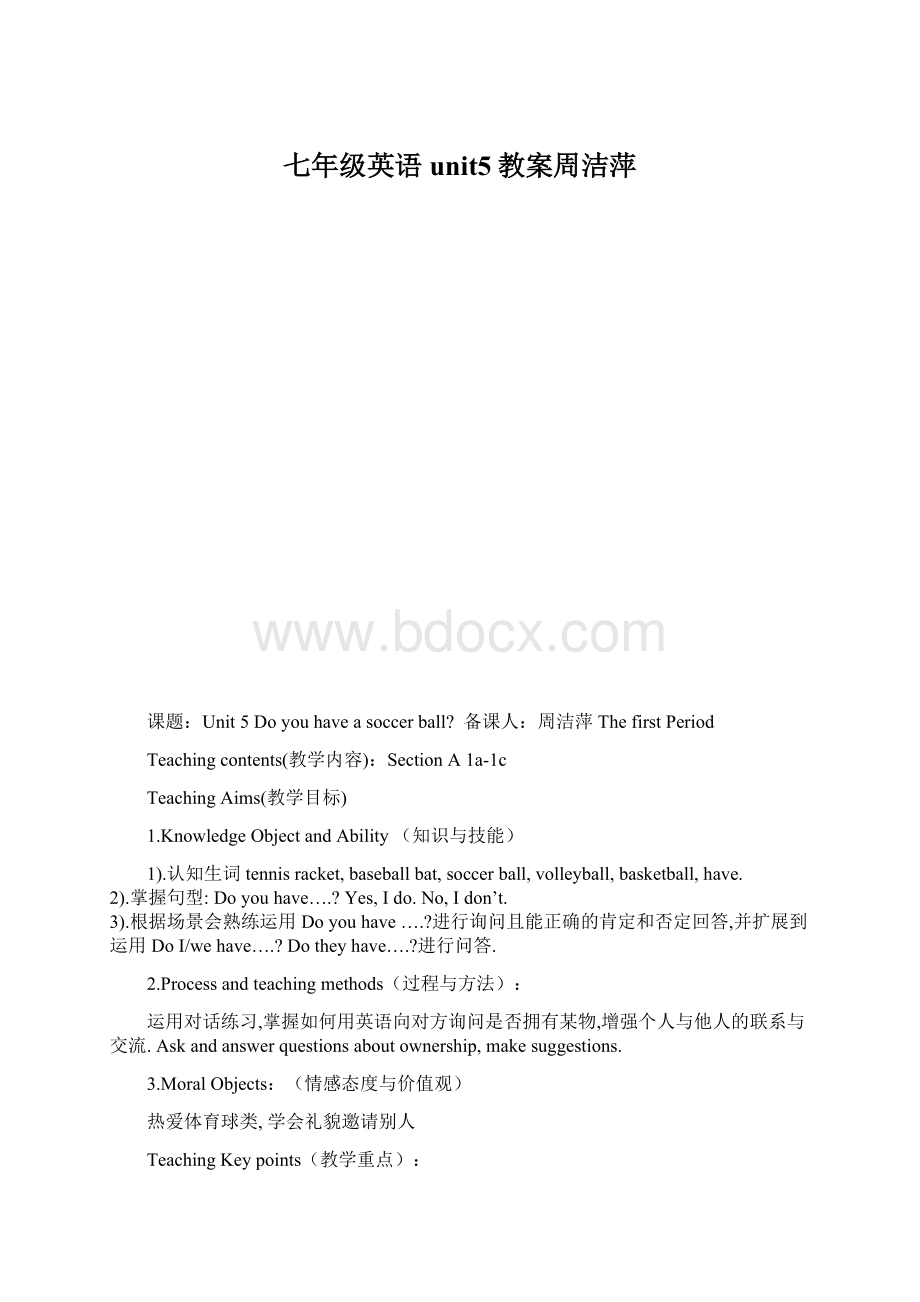 七年级英语unit5教案周洁萍Word格式.docx
七年级英语unit5教案周洁萍Word格式.docx
- 文档编号:21579087
- 上传时间:2023-01-31
- 格式:DOCX
- 页数:20
- 大小:24.83KB
七年级英语unit5教案周洁萍Word格式.docx
《七年级英语unit5教案周洁萍Word格式.docx》由会员分享,可在线阅读,更多相关《七年级英语unit5教案周洁萍Word格式.docx(20页珍藏版)》请在冰豆网上搜索。

TeachingKeypoints(教学重点):
1.学习并掌握词汇:
tennis
have.
2.学习并掌握句型:
have…?
do./No,
Teachingdifficultpoints(教学难点):
的一般疑问句用法(用于第一、二人称和第三人称的复数)及其肯定和否定回答
Teachingmethods(教学方法):
RoleplayingPairworkDemonstrationmethod
TeachingAids(教学用具):
Tape-recorder,pictures,objects
Classhour(课时):
One
TeachingDate(授课日期):
第_____周星期____月___日
BlackboardDesign(板书设计)
haveasoccerball?
/No,
basketball
Teachingprocedure(教学过程):
StepOne:
Warmingup.Greeting,
sing
an
English
song
together
ReviewthesentencestructureandthewordsinUnit4:
Makeconversationsabout“where-questions.”Suchas“WhereistheTV?
T:
Whereisyourbackpack?
S:
It’sinthedesk.
Whereareyourpencils?
S2:
Theyareinmypencil-case.
StepTwo:
Newwords
Thisactivityintroducesthekeyvocabulary
1.PresenttheNewwords.(show
a
soccerball).
Ask
the
student:
What’s
this?
It’s
ball.
ball.
Is
this
your
ball?
it
isn’t.
Yes./No.
volleyball.
volleyball?
Inthisperiod,askballsasmanyaspossible.suchas:
volleyball,badminton,pingpong,basketball,football,soccerballthatstudentsareinterestedin.
MakesuresomeofstudentsaregoodatplayingballsandIamsuretheycantalkmorethanteachers.So,askthemtotalkmore,Don’tcareabouttheyspeakEnglishorChinese.It’sveryimportanttomakeourclasslively.
Atthismoment,ask“Doyouhavefootball?
”Helpthemanswer“Yes,IdoorNo,Idon’t”
(Writedownthesentenceontheblackboard.)
2.LearntheNewwords.
show
picture
to
study
new
words:
volleyball,basketball,
television
学习方法:
先用图片认知单词,然后领读,注意讲解单词拼写和读音之间的联系,渗透音标教学.再用熟识的句型练习运用这些单词,让学生在不知不觉中达到熟识程度。
利用图片或realballs,beginnewwords,paymoreattentioninpronunciation.ifpossible,wehadbetterwrite音标。
注重发音。
Readthewordsaloud,makesuretheycanspeakwell.
如:
?
racket.
is.
Do
Yes,Ido./No,Idon’t.
StepThree:
1a
Thisactivityprovidespracticeinrecognizingspecificvocabularywordsinspokenconversation,andpracticelistening
First
do
exercises:
1a
(P25)
Match
words
with
things
in
picture.
Keys:
1.
c
2.
3.
e
4.
f
5.
d
6.
b
Listen
1b
finish
exercise.
Thenchecktheanswers.
Makesentences
practice
structure:
don’t.
StepFour.Pairwork
Practiceinpairs:
Doyouhavea…?
Yes,Ido.NoIdon’t.
Ifpossible,makeconversationlikethis:
What’sthis?
It’sabasketball.Isthisyourbasketball?
No,itisn’t.Doyouhaveabasketball?
No,Idon’t.themore,thebetter.
师生先进行对话,然后生生对话,可以用实物,也可以用图片,还可以用周围的事物.
following
pairwork:
1c
Pairwork
Let
students
ask
each
other:
baseball?
3
(P26)
Pairwork
look
at
picture.
partner
if
heorshe
has
these
with“Do
do.”
2a
2b(P26),
then
exercises.
Step
five.
现场调查
Thestudents
their
partners
he
or
she
pen,a
ruler,
sharpener
so
on.
让每个学生都参与到这个活动来,人人都有表现的机会。
Step6.
Summary
sum
up
what
we
learned
class.
Then
haven’t
understood.
7.
Homework
口语练习:
问你的父母,兄弟姐妹和你的好朋友是否有…..,然后把它记录下来.遇到的生词可以查词典,然后写到你的单词积累本上.
教学反思:
ThesecondPeriod
SectionA2a-3
1.KnowledgeObjectandAbility((知识与技能)
1
掌握生词television,
has,
does,
doesn’t,
collection,
but,
play
sports,
only,
them,
small,
every,
day,
every
day.
2.掌握句型Does
Does
及回答.
3.根据场景询问,
熟练应用句型进行交际.
利用录音,教学图片来开展课堂pairwork问答式的交际活动,是学生进一步学会基本句型“Does
及回答.”
3.MoralObjects(情感态度与价值观):
该部分学习内容贴近学生的生活,谈论同学是否拥有各种体育用品.
1学习并掌握词汇:
television,
day.
2学习并掌握句型:
及回答.
区分第三人称单数的用法.
听说练
Recorder,blackboard,pictures
One
第___周 星期______月_____日
BlackboardDesign(板书设计):
do.//
Does
he/she
…?
Yes,he/shedoes.//No,he/shedoesn’t.
TeachingProcedure(教学过程)
StepOne:
Greeting:
Checkthehomework.
Revise:
Doyouhaveatennisracket?
Doyouhavea….?
Andsomewordslearnedlastperiod,suchastennis,volleyball,ping-pongsoccerball….
Presentation
(to
boy)
pen?
do.
other
students)
does.
girl)
knife?
(
doesn’t.
学习单词:
(将单词板书,解释does,
doesn’t
是do,
don’t的第三人称单数,has
是have的第三人称单数,解释何为第三人称单数,以及它的用法)
Practicethedrills.
A.Listentotheconversation:
Tellthestudentsthattheywillheartheconversationsinthepictures.Playtherecordingthefirsttime.Studentslistenonly.Playagainforstudentstonamethepictures(1-4)
(Playthetapeagainandchecktheanswer.)
Whocananswer?
通过听力。
我们了解Doesyourbrotherhaveasoccerball?
No,hedoes.让学生观察doesanddo的用法。
B.show
picture.
(some
balls)
Please
dialogue
“Does
does.
doesn’t.”
Jane
Mike
Barry
Peter
baseball
√
Soccerball
volleyball
FourWrite
four
have?
Find
people
class
who
thesethings.
Write
names.
然后再将这些句子转换成他/她有
……吗?
练习两种句型
have…..?
he/
Five.
exercises
3a
(P29)
Read
magazine
article.
Circle
sports
things.
rackets,
basketballs,
baseballs,
balls,
volleyballs
出现的生词:
them
要求学生会读,认知其意义,当堂不必要求会拼写,可放到课后。
3b
Look
Fill
blanks
article
Sue
Swanson.
day.
要求学生认知并记住。
(small
可补充其反义词big,
可补充其他短语,如every
morning,
Sunday,
student等)
3a,
这两个题目是阅读类型,可让学生先按照要求去完成任务,然后让他们朗读全文,把握其全意,增强语感。
3c
本题目是复习生词,并扩展学生的词汇量,鼓励他们去接触新的单词。
StepSix:
Presentthegrammarandpractice.
back
(Grammar
Focus)
grammar
focus:
TV?
computer?
racket?
Chi-Young
hedoes.
总结句型,强调人称的变化和助动词的变化。
understood.Reviewthegrammarbox.Askstudentstosaythequestionsandanswers.Pointout“have–questionwithdoordoes”Doyouhaveapingpongball?
Yes,Ido.No,Idon’t.don’t=donot/doesn’t=doesnot.
(Thentheteacherwritesthesentencesontheblackboard.)
StepSeven.Summary
TodaywehavelearntWhere’ssentencesandhowtoanswer,andlearntotidyyourroom.
StepSeven.Homework:
口语练习:
向你的同桌询问,
Mike是否有字典?
Kate
是否有钢笔?
Jane是否有新自行车?
等等,然后把你的句子记录下来
教后感:
ThethirdPeriod
SectionA3a-SectionB2c
1.KnowledgeObjectandAbility(知识与技能)
:
掌握生词let,
us,
let’s,
play,
well,
sound,
good,
welcome
our,
sport,
center,
like,
we,
many,
club,
ping-pong,
more,
join,
class,
interesting,
boring,
fun,
difficult,
relaxing,
watch
TV.
(重点词汇:
let,
sound
good)
认知句型:
Let’s
…
That
sounds
good.
会用它向别人提出建议。
会用句型I
(We,
You,
They)
have….
He(She,
Kate,
Jane)
has….
及否定句自由表达。
2.Processandteachingmethods(过程与方法):
利用录音,教学图片来开展课堂pairwork问答式的交际活动
3.MoralObjects(情感态度与价值观):
训练学生的听说能力,增强学生的合作交流意识。
1.Newword:
let,
difficult
2.Targetlanguage:
Let’s
good.
Let’s
Practicing,Listening,reading,speaking,pairwork..
Recorder,blackboard,cards,picture
第___周 星期________月______日
Let’splayfootball.
Let’s=Letus
Thatsoundsgood/great.
=Thatisgood/great.
interesting,
relaxing,fun
TeachingProcedure(教学过程)StepOne:
Leading-in
Revisetheconversationbypracticethedetailsinlastperiod.M
- 配套讲稿:
如PPT文件的首页显示word图标,表示该PPT已包含配套word讲稿。双击word图标可打开word文档。
- 特殊限制:
部分文档作品中含有的国旗、国徽等图片,仅作为作品整体效果示例展示,禁止商用。设计者仅对作品中独创性部分享有著作权。
- 关 键 词:
- 年级 英语 unit5 教案 周洁萍
 冰豆网所有资源均是用户自行上传分享,仅供网友学习交流,未经上传用户书面授权,请勿作他用。
冰豆网所有资源均是用户自行上传分享,仅供网友学习交流,未经上传用户书面授权,请勿作他用。


 对中国城市家庭的教育投资行为的理论和实证研究.docx
对中国城市家庭的教育投资行为的理论和实证研究.docx
